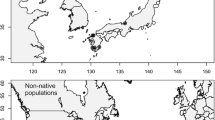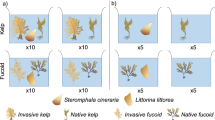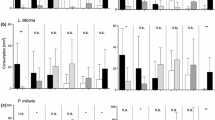Abstract
The host breadth of any particular herbivore reflects a compromise between evolutionary forces that promote specialism and those that promote polyphagy. Because most terrestrial herbivorous insects specialize, explorations of this evolutionary balance have focused largely on specialist than on polyphagous herbivores. Here, we experimentally tested whether fitness-based tradeoffs in utilizing alternative hosts can be detected within a polyphagous marine herbivore. The marine amphipod Ampithoe longimana occurs on multiple seaweeds year-round (especially the genera Sargassum, Ulva and Hypnea), but is particularly abundant on the diterpene-rich genus Dictyota during warmer summer months. If fitness-based tradeoffs in using these alternative hosts are present, A. longimana may experience fluctuating selection across seasons. To test this possibility, we performed a controlled natural-selection experiment in which amphipods were isolated on Dictyota or a mixed seaweed assemblage that did not include Dictyota. Within 15 weeks (less than five overlapping generations), Dictyota-lines had greater feeding tolerance for Dictyota and its secondary metabolites than did mixed-seaweed-lines. Dictyota-line females reproduced more quickly than did mixed-seaweed-line females on Dictyota, but mixed-seaweed-line juveniles had greater growth on Sargassum and Ulva and higher fecundity on all hosts than did Dictyota-line juveniles. While experimental shifts in preference and performance are likely genetically-mediated, our experimental protocol does not preclude a role for phenotypic plasticity. The presence of a fitness cost to evolving greater preference for Dictyota suggests that fluctuating selection may operate on feeding preference across seasons, but our test of this hypothesis was equivocal. We suggest that one reason that polyphagy persists within A. longimana and potentially other marine grazers is because polyphagy broadens resource use across seasons, and this benefit outweighs the fitness-based costs that can favor specialism. Our results also reinforce the notion that timescales of ecological and evolutionary dynamics can overlap.




Similar content being viewed by others
References
Amsler CD, Fairhead VA (2006) Defensive and sensory chemical ecology of brown algae. Adv Botanical Res 43:1–91
Anderson M (2001) Permutation tests for univariate or multivariate analysis of variance and regression. Can J Fish Aquat Sci 58:626–639
Bernays EA, Graham M (1988) On the evolution of host specificity in phytophagous arthropods. Ecology 69:886–892
Bernays EA, Minkenberg O (1997) Insect herbivores: different reasons for being a generalist. Ecology 78:1157–1169
Bolser RC, Hay ME (1996) Are tropical plants better defended? Palatability and defenses of temperate vs tropical seaweeds. Ecology 77:2269–2286
Brooks RA, Bell SS (2001) Mobile corridors in marine landscapes: enhancement of faunal exchange at seagrass/sand ecotones. J Exp Mar Biol Ecol 264:67–84
Bruno JF, O’Connor MI (2005) Cascading effects of predator diversity and omnivory in a marine food web. Ecol Lett 8:1048–1056
Bruno JF, Boyer KE, Duffy JE, Lee SC (2008) Relative and interactive effects of plant and grazer richness in a benthic marine community. Ecology 89:2518–2528
Cannicci S, Gomei M, Dahdouh-Guebas F, Rorandelli R, Terlizzi A (2007) Influence of seasonal food abundance and quality on the feeding habits of an opportunistic feeder, the intertidal crab Pachygrapsus marmoratus. Mar Biol 151:1331–1342
Canuel EA, Spivak AC, Waterson EJ, Duffy JE (2007) Biodiversity and food web structure influence short-term accumulation of sediment organic matter in an experimental seagrass system. Limnol Oceanogr 52:590–602
Cates RG (1980) Feeding patterns of monophagous, oligophagous, and polyphagous insect herbivores: the effect of resource abundance and plant chemistry. Oecologia 46:22–31
Cates RG (1981) Host plant predictability and the feeding patterns of monophagous, oligophagous, and polyphagous insect herbivores. Oecologia 48:319–326
Clements KD, Choat JH (1993) Influence of season, ontogeny and tide on the diet of the temperate marine herbivorous fish Odax-pullus (Odacidae). Mar Biol 117:213–220
Colin SP, Dam HG (2004) Testing for resistance of pelagic marine copepods to a toxic dinoflagellate. Evol Ecol 18:355–377
Cronin G, Lindquist N, Hay ME, Fenical W (1995) Effects of storage and extraction procedures on yields of lipophilic metabolites from the brown seaweeds Dictyota ciliolata and D. menstrualis. Mar Ecol Prog Ser 119:265–273
Cruz-Rivera E, Hay ME (2001) Macroalgal traits and the feeding and fitness of an herbivorous amphipod: the roles of selectivity, mixing, and compensation. Mar Ecol Prog Ser 218:249–266
Cruz-Rivera E, Hay ME (2003) Prey nutritional quality interacts with chemical defenses to affect consumer feeding and fitness. Ecol Monogr 73:483–506
Davenport AC, Anderson TW (2007) Positive indirect effects of reef fishes on kelp performance: the importance of mesograzers. Ecology 88:1548–1561
Duffy JE (1989) Ecology and evolution of herbivory by marine amphipods. University of North Carolina at Chapel Hill, Chapel Hill
Duffy JE, Harvilicz AM (2001) Species-specific impacts of grazing amphipods in an eelgrass-bed community. Mar Ecol Prog Ser 223:201–211
Duffy JE, Hay ME (1991) Food and shelter as determinants of food choice by an herbivorous marine amphipod. Ecology 72:1286–1298
Duffy JE, Hay ME (1994) Herbivore resistance to seaweed chemical defense - the roles of mobility and predation risk. Ecology 75:1304–1319
Duffy JE, Hay ME (2000) Strong impacts of grazing amphipods on the organization of a benthic community. Ecol Monogr 70:237–263
Duffy JE, Richardson JP, Canuel EA (2003) Grazer diversity effects on ecosystem functioning in seagrass beds. Ecol Lett 6:637–645
Duffy JE, Richardson JP, France KE (2005) Ecosystem consequences of diversity depend on food chain length in estuarine vegetation. Ecol Lett 8:301–309
France KE, Duffy JE (2006a) Consumer diversity mediates invasion dynamics at multiple trophic levels. Oikos 113:515–529
France KE, Duffy JE (2006b) Diversity and dispersal interactively affect predictability of ecosystem function. Nature 441:1139–1143
Fry J (1996) The evolution of host specialization: are trade-offs overrated? Am Natur 148:S84–S107
Fry JD (2003) Detecting ecological trade-offs using selection experiments. Ecology 84:1672–1678
Futuyma DJ (1976) Food plant specialization and environmental predictability in Lepidoptera. Am Nat 110:285–292
Futuyma D, Moreno G (1988) The evolution of ecological specialization. Ann Rev Ecol Syst 19:207–233
Gamfeldt L, Hillebrand H, Jonsson PR, Chase J (2005) Species richness changes across two trophic levels simultaneously affect prey and consumer biomass. Ecol Lett 8:696–703
Hairston NG, Holtmeier CL, Lampert W, Weider LJ, Post DM, Fischer JM, Caceres CE, Fox JA, Gaedke U (2001) Natural selection for grazer resistance to toxic cyanobacteria: Evolution of phenotypic plasticity? Evolution 55:2203–2214
Hairston NG, Ellner SP, Geber MA, Yoshida T, Fox JA (2005) Rapid evolution and the convergence of ecological and evolutionary time. Ecol Lett 8:1114–1127
Hay ME, Steinberg PD (1992) The chemical ecology of plant-herbivore interactions in marine versus terrestrial communities. In: Rosenthal G, Berenbaum M (eds) Herbivores: their interactions with secondary plant metabolites: ecological and evolutionary processes. Academic Press, San Diego, pp 371–413
Hay ME, Duffy JE, Pfister CA, Fenical W (1987) Chemical defense against different marine herbivores: are amphipods insect equivalents? Ecology 68:1567–1580
Hillebrand H, Gamfeldt L, Jonsson PR, Matthiessen B (2009) Consumer diversity indirectly changes prey nutrient content. Marine Ecol Prog Ser 380:33–41
Jaenike J (1978) Resource predictability and niche breadth in the Drosophila quinaria species group. Evolution 32:676–678
Jaenike J (1990) Host specialization in phyophagous insects. Annu Rev Ecol Syst 21:243–273
Jaschinski S, Sommer U (2008) Functional diversity of mesograzers in an eelgrass-epiphyte system. Mar Biol 154:475–482
Jaschinski S, Aberle N, Gohse-Reimann S, Brendelberger H, Wiltshire K, Sommer U (2009) Grazer diversity effects in an eelgrass–epiphyte–microphytobenthos system. Oecologia 159:607–615
Jormalainen V, Honkanen T (2008) Macroalgal chemical defenses and their roles in structuring temperate marine communities. In: Amsler CD (ed) Algal chemical ecology. Springer, Heidelberg, pp 57–89
Jormalainen V, Honkanen T, Heikkila N (2001) Feeding preferences and performance of a marine isopod on seaweed hosts: cost of habitat specialization. Marine Ecol Prog Ser 220:219–230
Kassen R (2002) The experimental evolution of specialists, generalists, and the maintenance of diversity. J Evol Biol 15:173–190
Kotta J, Orav-Kotta H, Paalme T, Kotta I, Kukk H (2006) Seasonal changes in situ grazing of the mesoherbivores Idotea baltica and Gammarus oceanicus on the brown algae Fucus vesiculosus and Pylaiella littoralis in the Central Gulf of Finland, Baltic Sea. Hydrobiologia 554:117–125
Levins R (1968) Evolution in changing environments; some theoretical explorations. Princeton University Press, Princeton, p 132
McCarty AT (2008) Regional variation in feeding preferences of the marine herbivore Ampithoe longimana Biology. College of Charleston, Charleston, p 89
Meyer J, Ingersoll C, McDonald L, Boyce M (1986) Estimating uncertainty in population growth rates: jackknife vs. bootstrap techniques. Ecology 67:1156–1166
Nelson WG (1980) The biology of eelgrass (Zostera marina L.) amphipods. Crustaceana 39:59–89
Novotny V, Basset Y (1998) Seasonality of sap-sucking insects (Auchenorrhyncha, Hemiptera) feeding on Ficus (Moraceae) in a lowland rain forest in New Guinea. Oecologia 115:514–522
Novotny V, Basset Y (2005) Review: Host specificity of insect herbivores in tropical forests. Proc R Soc Ser B 272:1083–1090
Novotny V, Basset Y, Miller SE, Weiblen GD, Bremer B, Cizek L, Drozd P (2002) Low host specificity of herbivorous insects in a tropical forest. Nature 416:841–844
Padilla D (1985) Structural resistance of algae to herbivores. Mar Biol 90:103–109
Paul VJ, Cruz-Rivera E, Thacker RW (2001) Chemical mediation of seaweed-herbivore interactions: ecological and evolutionary perspectives. In: McClintock JB, Baker B (eds) Marine chemical ecology. CRC Press, Boca Raton, pp 227–266
Poore AGB (2004) Spatial associations among algae affect host use in a herbivorous marine amphipod. Oecologia 140:104–112
Poore AGB, Hill NA (2006) Sources of variation in herbivore preference: among-individual and past diet effects on amphipod host choice. Mar Biol 149:1403–1410
Poore AG, Hill NA, Sotka EE (2008) Phylogenetic and geographic variation in host breadth and composition by herbivorous amphipods in the family ampithoidae. Evolution 62:21–38
Poore A, Campbell A, Steinberg PD (2009) Natural densities of mesograzers fail to limit growth of macroalgae or their epiphytes in a temperate algal bed. J Ecol 97:164–175
Price PW (2003) Macroevolutionary theory on macroecological patterns. Cambridge University Press, Cambridge, p 302
Rausher MD (1992) Natural selection and the evolution of plant-insect interactions. In: Roitberg K, Isman MB (eds) Insect chemical ecology: an evolutionary approach. Chapman and Hall, New York, pp 20–88
Richardson JP (1979) Overwintering of Dictyota dichotoma (Phaeophyceae) near its northern distribution limit on the east coast of North America. J Phycol 15:22–26
Sainte-Marie B (1991) A review of the reproductive bionomics of aquatic gammaridean amphipods—variation of life-history traits with latitude, depth, salinity and superfamily. Hydrobiologia 223:189–227
Schoonhoven LM, van Loon JJA, Dicke M (2005) Insect-plant biology. Oxford University Press, New York, p 440
Singer MS (2008) Evolutionary ecology of generalism. In: Tilmon KJ (ed) Specialization, speciation, and radiation: the evolutionary biology of herbivorous insects. University of California Press, Berkeley, pp 29–42
Sokal RR, Rohlf FJ (1981) Biometry, 2nd edn. W.H. Freeman and Company, New York
Sotka EE (2003) Genetic control of feeding preference in the herbivorous amphipod Ampithoe longimana. Mar Ecol Prog Ser 256:305–310
Sotka EE, Giddens H (2009) Seawater temperature alters feeding discrimination by cold-temperate but not subtropical individuals of an ectothermic herbivore. Biol Bull 216:75–84
Sotka EE, Hay ME (2002) Geographic variation among herbivore populations in tolerance for a chemically-rich seaweed. Ecology 83:2721–2735
Sotka EE, Wares JP, Hay ME (2003) Geographic and genetic variation in feeding preference for chemically defended seaweeds. Evolution 57:2262–2276
Sotka EE, Forbey J, Horn M, Poore AGB, Raubenheimer D, Whalen KE (2009) The emerging role of pharmacology in understanding consumer-prey interactions in marine and freshwater systems. Integr Comp Biol 49:291–313
Southwood TRE (1978) Ecological methods, with particular reference to the study of insect populations. Chapman and Hall, London
Steneck RS, Watling L (1982) Feeding capabilities and limitation of herbivorous molluscs: a functional group approach. Mar Biol 68:299–319
Strauss SY, Zangerl AR (2002) Plant-insect interactions in terrestrial ecosystems. In: Pellmyr O, Herrera CM (eds) Plant-animal interactions: an evolutionary approach. Blackwell Science Ltd, Oxford, pp 77–106
Strong DR, Lawton JH, Southwood SR (1984) Insects on plants: community patterns and mechanisms. Harvard University Press, Cambridge
Tegner MJ, Dayton PK (1987) El Niño effects on southern California kelp forest communities. Adv Ecol Res 17:243–279
Thompson J (1998) Rapid evolution as an ecological process. Trends Ecol Evol 13:329–332
Tilmon KJ (2008) Specialization, speciation, and radiation: the evolutionary biology of herbivorous insects. University of California Press, Berkeley, p 360
Trowbridge CD (1991) Diet specialization limits herbivorous sea slug’s capacity to switch among food species. Ecology 72:1880–1888
Trowbridge CD, Todd CD (2001) Host-plant change in marine specialist herbivores: ascoglossan sea slugs on introduced macroalgae. Ecol Monogr 71:219–243
Vesakoski O, Rautanen J, Jormalainen V, Ramsay T (2009) Divergence in host use ability of a marine herbivore from two habitat types. J Evol Biol 22:1545–1555
Wiklund C, Friberg M (2009) The evolutionary ecology of generalization: among-year variation in host plant use and offspring survival in a butterfly. Ecology 90:3406–3417
Wolda H (1988) Insect seasonality: why? Annu Rev Ecol Syst 19:1–18
Acknowledgments
We thank Artur Veloso, John Bruno and the University of North Carolina’s Institute of Marine Sciences for logistical support, Tina Bell, Mark Hay and Bob Podolsky for thoughtful discussions, and the National Science Foundation for funding (OCE-0550245; DEB-0919064). This is Grice Publication Number 364.
Author information
Authors and Affiliations
Corresponding author
Rights and permissions
About this article
Cite this article
Sotka, E.E., Reynolds, P.L. Rapid experimental shift in host use traits of a polyphagous marine herbivore reveals fitness costs on alternative hosts. Evol Ecol 25, 1335–1355 (2011). https://doi.org/10.1007/s10682-011-9473-y
Received:
Accepted:
Published:
Issue Date:
DOI: https://doi.org/10.1007/s10682-011-9473-y




